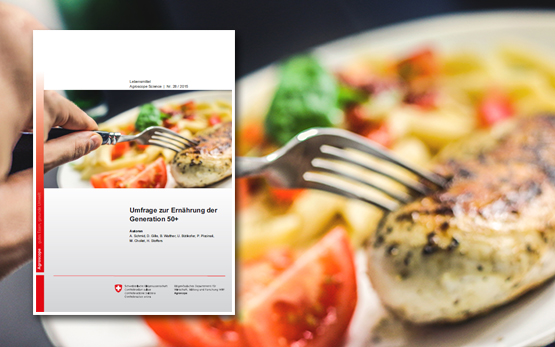Fritsch L., Wagner E., Aeschlimann T., Marti Serrano E.
When the solution is part of the problem - A Listeria monocytogenes case study of an alpine cheese dairy.
In: IAFP European Symposium. 30 April, Hrsg. IAFP, Geneva. 2024.
Berger T., Aeschlimann T., Haldemann J., Fehér N., Winkler H.
Beurteilung von Schweizer Käse bezüglich der ParaTB-Anforderungen für den Export in die EAWU: Beurteilung z.H. Plattform Agrarexport (PAE).
Hrsg. Agroscope, 29. Januar, 2024, 3 S.
Aeschlimann T.
Listerien bei der Käseherstellung und –reifung.
In: LaBeCo Gruyère- und Halbhartkäsetagung. 28. Oktober, Sempach. 2023, 1-53.
Aeschlimann T., Ernst Jakob.
Listerien bei der Käseherstellung und –reifung.
In: Lieferantentagung der Sortenorganisation Bündner Bergkäse. 12. September, Vals. 2023.
Aeschlimann T.
Neue Kulturen im Verkaufsangebot.
In: LaBeCo. 1. Juni, Alberswil. 2023.
Aeschlimann T.
Beeinflusst das Melksystem die Käsereimilchqualität?
In: LaBeCo. 1. Juni, Alberswil. 2023.
Aeschlimann T.
Butterherstellung auf den Alpen: Teil 3.
In: Weiterbildung Glarner Alpen. 20. April, Lanquart. 2023, 1-23.
Fröhlich-Wyder M. T., Aeschlimann T., Winkler H., Bachmann H.-P.
Simmentaler Original: The first Swiss cheese made from the milk of a single cow breed.
In: Conference 2023 Face-Network. 12 October, Grangeneuve. 2023, 1.
Häni W., Fehér N., Aeschlimann T., Haldemann J.
Einfluss des Gerinnungsmittels auf die Qualität von Raclettekäse aus thermisierter Milch.
Agroscope Transfer, 495, 2023, 1-13.
weitere Sprachen: französisch
Kohn C., Aeschlimann T.
Alles andere als oberflächlich.
IG-Alp Infopost, 23, 2023, 30-35.
Guggisberg D., Skeie S., Haldemann J., Aeschlimann T., Schmidt R., Maurer J., Walther B.
Nicht jede Milch verhält sich gleich im Käsekessel: Der Vergleich von Kuh-, Ziegen- und Schafmilch betreffend Qualitäts- und Koagulationseigenschaften bei der Käseherstellung.
Lebensmittel-Technologie, 07-08, 2022, 30-31.
Fröhlich-Wyder M. T., Bachmann H.-P., Von Ah U., Baumeyer Brahier A., Irmler S., Aeschlimann T., Cocuzzi R., Turgay M., Schmidt R.
Impact of pediococci on the amino acid profile of a model-cheese with propionic acid fermentation.
In: 23ème colloque du Club des Bactéries Lactiques. 8 - 10 juin, Hrsg. UMR INRAE - Institut Agro STLO, Rennes, F. 2022.
Guggisberg D., Aeschlimann T., Walther B.
Der richtige Milchschaum für den Cappucino.
Lebensmittel-Technologie, 3, 2022, 28-29.
Aeschlimann T.
Herstellung/Vermarktung von Ziegen - und Schafkäse.
In: Plantahof. 01.12., Landquart. 2021, 1-41.
Aeschlimann T.
Alternative Trockensteller - Gefahr für die Käsequalität.
In: Bündner Bergkäse. 01.12., Landquart. 2021, 1-69.
Aeschlimann T.
Alternative Trockensteller - Gefaht für die Käsequalität.
In: LaBeCo. 16.11., Alberswil. 2021, 1-71.
Aeschlimann T.
Kulturenproduktion: PPP - Public Private Partnership (seit 2019).
In: Beratertagung. 26.10., Liebefeld. 2021, 1-19.
Aeschlimann T., Winkler H.
Überlegungen zur Optimierung von der Qualitätskontrolle der Milch bis zur Bruchbereitung.
In: Sortenorganisation Appenzeller. 30.Juni, Bazenheid. 2021, 1-31.
Aeschlimann T., Winkler H.
Überlegungen zur Optimierung von der Qualitätskontrolle der Milch bis zur Bruchbereitung: DG-Weiterbildung Sommer 2021.
In: CASEI. 29. Juni, Affoltern. 2021, 1-30.
Aeschlimann T., Winkler H.
Überlegungen zur Optimierung von der Qualitätskontrolle der Milch bis zur Bruchbereitung: Allg. Käseherstellung, Ergebnisse PV HNK-ES.
In: BAMOS. 23.06., Bazenheid. 2021, 1-30.






